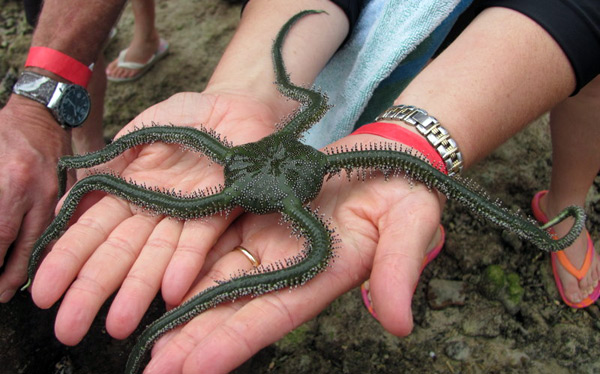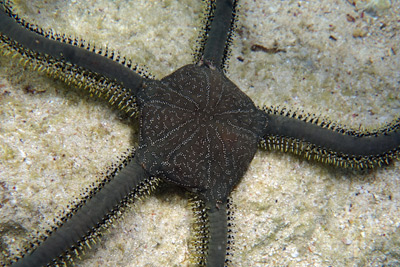“Voracious predator” is not a term one commonly associates with brittle stars—that is, of course, unless the brittle star in question happens to be Ophiarachna incrassata, or the green brittle star (aka “the green death”). This bold species has a well-earned reputation for not merely scavenging deceased small fish and motile invertebrates, as one might assume, but also for actively hunting and capturing these animals while they’re still alive and kicking.
Physical appearance
O. incrassata, as its common name implies, is muted green overall with lighter colored dots forming a radial pattern on the central disc. Whitish to yellowish spines line either side of each arm. Specimens can reach a rather prodigious size of around 20 inches in diameter (arm tip to arm tip, that is).
Feeding
This brittle star is not a finicky eater. It will accept pretty much any foods offered to fish as well as consume detritus. But as mentioned, it will also capture and consume small fish and motile invertebrates, such as ornamental shrimps, often under cover of darkness.
This species has been known to prop itself up on its arms with its oral disc suspended above the substrate and patiently wait for a fish to venture underneath. If one does, the brittle star can then “spring the trap” by dropping down and simultaneously enwrapping the fish in its arms.
Some hobbyists report that this species’ tankmate-eating behavior can be curtailed by keeping it well fed. Nonetheless, I would be wary of opportunistic hunting of any specimens that seem to present “easy pickings.”

Housing
O. incrassata gets quite large, requires ample rockwork to hide in, and doesn’t take well to fluctuating water parameters. Thus, it does need a decent-sized aquarium to thrive. I would target something in the vicinity of at least 50 gallons for a larger specimen.
Compatibility
As far as any tankmates go, you’ll want to avoid small fish, especially benthic types, as well as ornamental crustaceans and possibly other small motile invertebrates. Larger fish will likely be safe, but then you have to ensure they won’t be inclined to attack or nip at the brittle star.
Apart from the tendency to eat certain motile invertebrates, O. incrassata is technically reef safe, meaning, to the best of my knowledge, it won’t bother corals and other sessile invertebrates (though I’m curious whether any salties out there have had experiences that suggest otherwise).



